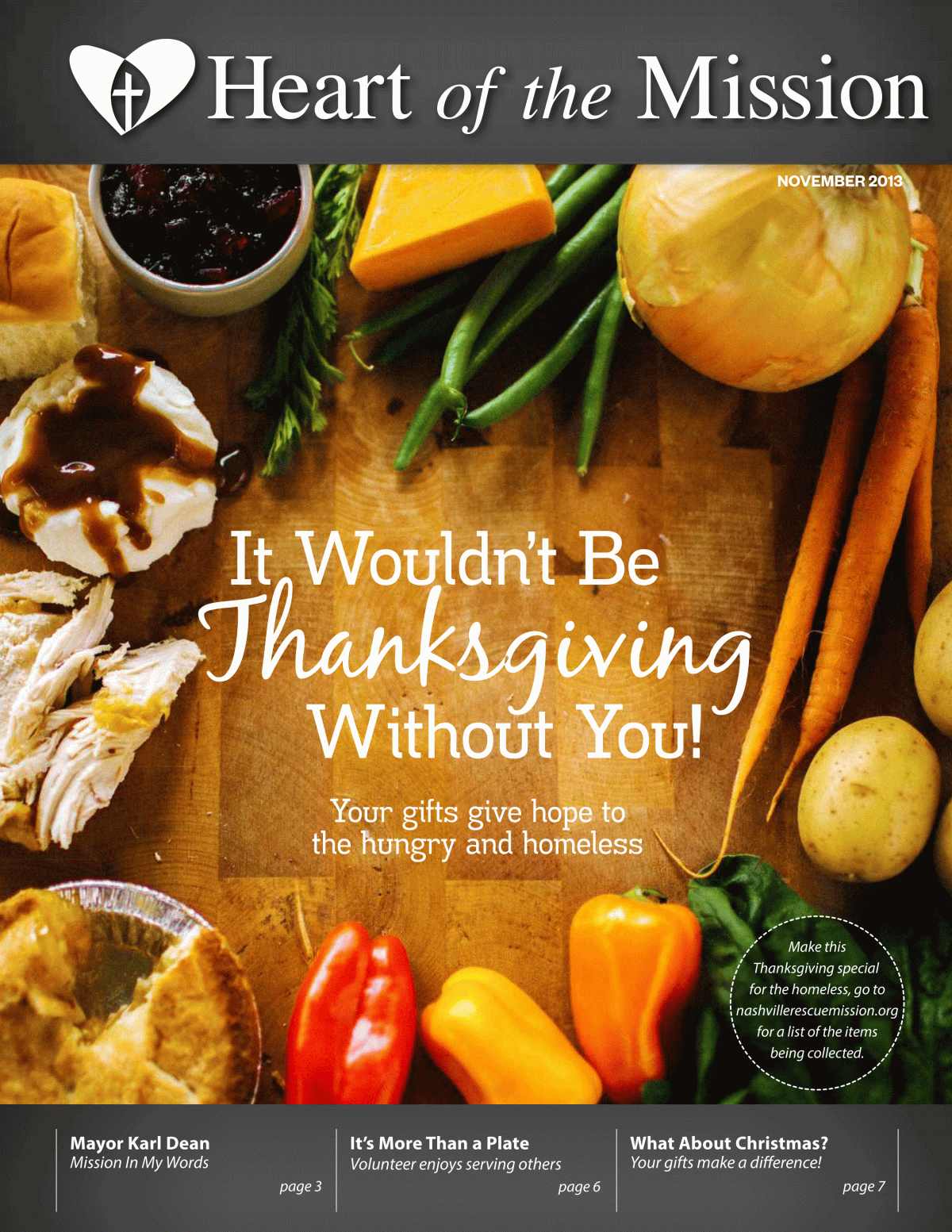Interview with Michelle Brinson by Pam Grow
1. Michelle, tell us a little bit about Nashville Rescue Mission and your job. What’s your background and when did you start? Tell us what the newsletter looked like when you came onto the picture.
Nashville Rescue Mission opened in 1954 to provide food, clothing and shelter to homeless men in Nashville. Over the years NRM has expanded and now includes services for homeless women and children. In 2012, the Mission served over 665,000 meals and provided over 220,000 nights of safe shelter. NRM doesn’t receive any government funds.
I came to NRM in 2008 with over 20 years of marketing experience. Having developed a passion for sharing stories, I was hired to tell the Mission’s story to donors. Through newsletters, annual reports, emails, web content and other marketing communication pieces, my goal is to share “the story” in a way that inspires and motivates people to take action.
It is through the support of donors, NRM provides services that change lives. The Mission exists through the generosity of individual donors who make up 85% of money received. They need to know their gifts make a difference.
In 2008, a black and white, one-spot color newsletter was mailed monthly to 40,000 donors. Over time, we’ve added more color, increased visuals and focused on thanking donors. All calls to action are soft. It is a team effort involving a writer (me), a graphic designer, photographer, good data and lots of input from others in our organization.
 2. You’ve shared some pretty impressive numbers. My understanding is that Nashville Rescue Mission’s newsletter brings in over $2 million a year. Can you tell us about your audience, how you mail your newsletter, if you have a set formula, how often you mail, etc.?
2. You’ve shared some pretty impressive numbers. My understanding is that Nashville Rescue Mission’s newsletter brings in over $2 million a year. Can you tell us about your audience, how you mail your newsletter, if you have a set formula, how often you mail, etc.?
NRM’s print newsletter is an 8-page, 4-color, full-bleed newsletter mailed monthly to donors who give frequently and consistently. This year, the newsletter will break $2M in revenue. In total, cash revenue for the organization is a little over $9M.
The audience averages from 55K to 75K donors. Those who receive the newsletter are frequent, consistent and the most generous donors. We increase quantities during major holiday cycles, which includes Easter, Thanksgiving and Christmas.
NRM works with a local company who handles printing and mailing. Through data NRM supplies, the printer can customize response cards prefilled with the donor’s information and suggested amounts based on previous amounts given.
3. How do you find the stories for NRM’s newsletter? How many stories are used in each newsletter, and do you have any sort of system to repurpose the stories on your website, enews or on your social media accounts?
Each newsletter has a theme. August focuses on back to school and November focuses on Thanksgiving. I look for stories, which tie in with the theme. I depend on various team members who work with guests, clients and volunteers to be my “eyes and ears.”
The front cover and center spread are the lead story. It’s 800 to 900 words, has lots of photos and pull quotes. Page two is a letter from our President and CEO and below that is a “plea” area that changes each month.
Page three is an article from someone who would be recognizable in the community entitled “Mission In My Words.” Past examples would include the Mayor of Nashville, the Governor of Tennessee and Dave Ramsey, just to name a few. Typically, I interview them, then ghost write an article they approve. This story lends credibility to supporting the Mission.
Page six varies depending on actionable items, like the need for Christmas gifts for women and children or water in the summer. Page seven features a volunteer. I share stories of volunteers who serve meals, as well as those who are using their specific gifts in different ways, like tutoring students, teaching computer classes, etc.
The back cover is visual and focuses on upcoming events or specific needs.
The mailing envelope has a photo of the cover image from the newsletter, along with the lead story headline in color, and the phrase “November Newsletter Enclosed” printed at the bottom of the envelope. (It helps distinguish it from other mailings.)
I edit stories down for the web, which we feature on the home page with a large visual linking to the story. I add a call to action at the bottom of the story, to appeal to a prospective donor, which is typical of visitors to our site.
I pull stories from the print newsletter for the monthly email blast. I’m looking at ways to grow the list and am considering an increase in frequency.
We hired a full-time social media person in early 2013 who also repurposes content.
4. What types of reactions do you receive from your donors on your donor newsletter?
I love it when we get a letter from someone who has read a story and was so moved, they took the time to not only send in a donation, but also share something about the story or person that touched them. I’ve even had men and women featured in a story come back and tell me someone recognized them in a store or on the city bus.
5. Do you work with an outside designer? Do you have any tips for our readers on photographs or printing?
Outside of printing and mailing, everything is done in-house. Our marketing team consists of a graphic designer, a writer (me) and a social media specialist.
Start with a good camera and a great lens. All three of us have strong photography skills, so we usually know what shot we want. We almost never use stock photos… and when we do, they are usually for background or texture.
It’s imperative to have a good working relationship with your printer. They can provide great ideas, ways to improve processes or save money. I like that our printer can custom print reply cards based on data given to them. This has led to increased donations.
6. Anything else you’d like to share with our readers?
It’s critical to have a passion for the story you’re telling. If you don’t, the reader won’t feel it, be inspired by it or moved to do something about it. It will fall flat.
Don’t be afraid of editing. It’s harder to write shorter stories, but worth it.
You won’t read, “We did this,” or “Nashville Rescue Mission did that.” Instead, you’ll read stories of lives changed as a result of gifts from donors. Donors are the heroes!
The reward of giving is knowing someone’s life is changed by the gift.





